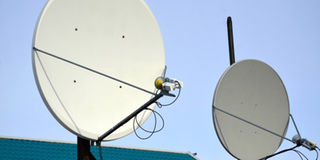Are Ugandans ready for digital migration tomorrow?

Starting tomorrow, there will be a change in television transmission as the country switches to digital transmission.
What you need to know:
The countdown to digital migration has narrowed to hours. In spite of the June 17 international deadline, there are still questions as to whether we are ready for the leap.
With the international deadline for the transition from analogue to digital broadcasting here, in Uganda, a dark cloud hangs over the preparedness and fate of most TV consumers.
Tomorrow, June 17 is the deadline. The date was set in Geneva, Switzerland at a 2006 meeting of the 198 member nations of the International Telecommunications Union (ITU) meeting.
ITU is the United Nations agency that allocates radio spectrum and satellite orbits.
While, the telecommunications regulator, Uganda Communications Commission (UCC), says “everything that is required” for the transition is in place.
And Uganda Broadcasting Corporation’s (UBC) affiliate body, Signet, established to spearhead digital migration, says the country is ready.
Contention
TV broadcasters under the National Association of Broadcasting (NAB) have scorned the process as not well-thought out.
They say the digital switch over on Wednesday could plunge the country into disaster owing to the pitiable state of preparation.
Since yesterday, UBC/Signet has been testing the switch off for the first phase.
What it is
Digital migration or ‘switchover’ is ththe process of changing from analogue terrestrial television, where television broadcast services are transmitted on VHF (Band III) and UHF (Bands IV and V), to digital terrestrial television (DTT), where signals are carried on a multiplex.
It can carry many televisions in the same frequency channel as one analogue television service.
Why the switch?
Compare analogue TV technology to the negative film cameras. One photographic film would take a maximum of 36 images. But digital cameras, most of which use memory cards; one can hold, depending on the settings, between 500 and 1,000 images at once.
Fred Otunnu, the acting director for broadcasting, UCC, said the reason for terrestrial digital broadcasting is to have coordination for frequencies and have usage of spectrum leveraged.
“The electromagnetic spectrum is congested and needs to be freed up,” he explained.
“Currently, TV channels on spectrum are limited. However, digital technology will help to fuse them thereby reducing the space occupied, creating lots of programming and better quality for consumers,” he said.
The variations
For digital TV, signals are encoded and compressed to allow for more channels to be broadcast.
Digital broadcasting takes two standards; Digital satellite broadcasting, which requires use of a satellite dish to capture data transmissions from long distances. In Uganda, this is already offered by service providers like DStv and Azam TV among others.
The other is digital terrestrial broadcasting where an outdoor antenna is required to capture signals from the signal distributor and set top box/decoders to convert them into images.
Service providers like GoTV and StarTimes are already positioned in the market with this pay/subscription TV standard.
However, for most Ugandans who cannot afford paying for TV, UCC says it is pushing for free-to-air terrestrial broadcasting. Otunnu explained there are different packages. When consumers buy free-to-air set top boxes, they are only limited to local channels.
Players
According to UCC, there are about 24 TV channels broadcasting in Uganda. However, less than 10 channels are accessible on both satellite and terrestrial broadcasting.
Ipsos Synovate findings show there are 3.5 million TV users in the country.
However, majority cannot afford pay TV and since we are obliged to safeguard interests of consumers we approved sale and distribution of free to air set top boxes.
UCC last month published a list of 13 approved distributors of set top boxes with about 20 agents outlets across the country.
On the other hand, there is also Integrated Digital Television sets (IDTVs)-flat screens, which are sold with in-built digital systems.
For this, consumers do not require antennae and STBs. They are already in the country.
The in-built systems allow digital processing and compression of broadcasts for better quality transmissions.
Works on Signet sites
Signet will pick signals from every station and distribute them. Eng. Batanda, however, said works on seven upcountry sites is ongoing to aid signal distribution. These include satellite stations in Masaka, Hoima, Mbarara, Mbale, Masindi, and Kololo.
Other sites to come on board by August include, in Jinja, Lira, Kiboga, Ntungamo, Rukungiri, Rubirizi, Soroti, Gulu and Kabale.
According to ITU, once the digital switch is achieved, there will be large amounts of spectrum freed for other services like satellites and mobile telephony.
Preparedness to switch-off
UCC as a regulator is working closely with Signet, which will be the signal distributor for terrestrial broadcasting—especially free to air broadcasting.
Signet was established late last year after electronic media operators, notably TV broadcasters opposed the move to have UBC—itself a national broadcaster—in the charge of signal distribution.
The opposition was in context that UBC is a competitor and cannot help distribute signals.
UCC says it will switch off analogue broadcasting within a radius of 65 kilometres from the main Signet transmission centre in Kololo, Kampala.
This will affect areas between Mityana to the east, Wobulenzi to the North, Mbizi nnya/Mpigi-Masaka districts to the south east and Entebbe.
Otunnu explained that both digital and analogue technologies are in use up to June 17.”
Eng Sam Batanda, the head of Signet, told Daily Monitor the digital switch off will be carried out in phases. Phase one commences on June 17; phase two on July 31, and phase three on August 30. All these will be spread out across the country.
“For now everything is adequate to facilitate the switch off but there a few things we put in place as we go along, and also the unforeseen circumstances,” Batanda said. “There are still shadow areas within that 65km radius like Entebbe where signals are still problematic but we are working on it.”
What next?
After migration because broadcasting will be fused, TV broadcasters will now take on the description of content providers. According to Signet, there are 24 content providers within Kampala region.
“Under analogue, there is constrained choice of programming due to limited space for channels. For example, a person in Mbarara cannot access TV channels from Kampala so they are limited to one or two channels broadcasting from that area. Digital however aims at reducing this distance,” Batanda explained.
Under this arrangement, Signet picks up signals from each of the TV stations at their locations and transmits them to a wider spectrum. For transmission of a programme/channel around Kampala, a licence costs about Shs12m ($4,000) and Shs8m ($2,500) those up-country per month.
Batanda attributes these rates to the fact that digital broadcasting is based on the use of digital transmission technologies such as Digital Video Broadcasting -Terrestrial decoders (DVB-T) video and audio compression technologies such as MPEG 2/4 which ensure better quality.
UCC also says they created a new licencing regime. A regional licence broadcasts in a region and when they cross in all the 10 regions they become a national broadcaster.
Consumer choices
Consumers will be faced with the option of either buying the approved DVB-T2 decoders from any of the subscription TVs at various prices—lower but for pay per view and applicable to packages paid for, or buy the free-to-air set top boxes from the listed vendors within the range of Shs130,000 to Shs180,000.
The problem is, according to NAB, they are expensive for ordinary Ugandans. Worst of all, there fewer in the market—about only 10,000 have been sold to date.
Pay Tv players take
MultiChoice’s general manager, Charles Hamya, said Uganda has made significant progress in ensuring that the country is ready for digital migration.
The government has already set up digital network infrastructure, which is being tested in an attempt to smoothly migrate as many television viewers from analogue to digital television.
“To contribute to the country’s readiness, MultiChoice Uganda, through its DTH and DTT services GOtv and DStv, continues to make set-top boxes (decoders) more affordable,” Hamya noted.
We have seen an increase in the demand and need for set top boxes (decoders) accelerated by the significant reduction in decoder prices, however, as we get closer to the digital migration deadline, we suspect the demand will rise.
Going digital means television viewers can now have more choice as additional channels will become available to them in improved digital quality sound and picture.
Broadcasters cast doubt on the process
Since the 2006 agreement, different countries around the world set themselves different targets below 2015. The East African Community members for example, first set themselves up to 2012 to comply but understandably each kept shifting goal posts.
Uganda first set 2010, then 2012, then December 2014 and now June 17 (tomorrow). Elsewhere in Africa, many countries are still struggling.
Tanzania and Rwanda are the only African countries to have completely migrated. Kenya tested switch off last year sparking off a protracted battle with private broadcasters. But, in February it was announced that the country had fully migrated.
Limited mass awareness, funding for migration, and infrastructure and technical glitches are some of the concerns put forward to highlight a bumpy ride ahead of the Wednesday deadline.
The association of broadcasters in Uganda, NAB, last Friday petitioned Speaker of Parliament Rebecca Kadaga, and the ICT committee, led by Vincent Bagire, that Uganda is not ready for the 17th June deadline.
“There is need to agree on a smooth transition roadmap that will not force Ugandans to turn into Pay TV viewers,” the petition signed by NAB chairman Kin Kariisa, read in part. “We have been in dialogue with the regulator UCC and UBC/Signet and agreed to a roadmap which we wish can be considered for implementation to avoid the shutdown.”
NAB argued that government was “supposed to prioritise consumer awareness (education) and skills development to assist in access and utilisation of digital broadcasting systems as well as guarding against consumer exploitation through unfair market practices” which has been lukewarm, coupled with many technical gaps on the ground.
Eng Sam Batanda, the head of Signet, however said from recent meetings with NAB, they have not expressed any fear but rather pledged support to the migration process. “We have been piloting digital broadcasting for the past 18 months and there has not been any problem.”
Otunnu holds a similar view. “Readiness is relative but we feel we have played our part; we have put in place the regulatory framework, and our emphasis now is on free to air broadcasting.”
He added, “We stick with the June 17th deadline because it is the ITU deadline for all countries. So ,we don’t want to create a scenario where we are seen as defiant because it is us (countries) that set that target.”




